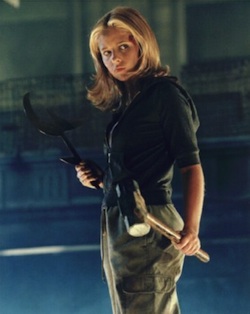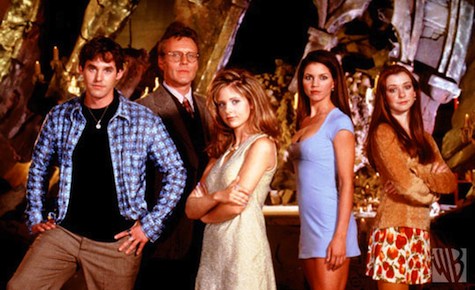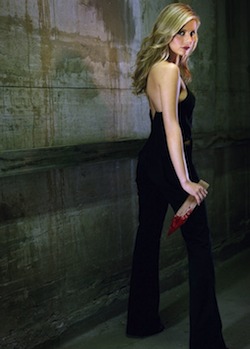Here’s a little something to blow everyone’s minds: this being 2012, March 10th will mark the fifteenth anniversary of the Buffy the Vampire Slayer premiere on the now-dead WB Television Network. What’s more, the BtVS film, starring Kristy Swanson, hit screens in 1992, five years earlier. By my reckoning, friends and fandom, that makes the Slayer franchise just about old enough to gamble.
This calls for some partying, don’t you think? And also, perhaps inevitably, a rewatch.
When I contemplated looking at all of BtVS again, not quite a decade since “Chosen” brought down the curtain on Sunnydale, California, I decided not to dive right into “Welcome to the Hellmouth” and “The Harvest.” First, I thought, I’d take a quick glance at the original film. Remember this?
Buffy the Vampire Slayer (version 1.0) was a weird mix of action, girl power and broad, occasionally dumb, comedy. I saw it in the theater, for some reason, and enjoyed it more than it perhaps deserved. Kristy Swanson made a good Buffy, I thought, vulnerable and tough by turns. Rutger Hauer delivered good villain cheese, as he always does, and Donald Sutherland as Merrick was a perfectly adequate Watcher. This first Buffy’s growth into the Slayer role—despite the silly gags that undermined the powerful underlying story and Joss Whedon’s crackling dialog—had moments that were truly engaging.
Still, we all know it couldn’t hold a candle to the series, right?
“Welcome to the Hellmouth” throws a tentative storyline back to the original film, without locking itself into its canon. Buffy has been kicked out of school… the one, we’re left to assume, that we saw in the movie. She and a much more attentive version of her mom have ditched dad and moved to a new town. The fate of her previous Watcher is left murky—we are left to remember Merrick, and his death, without dwelling on it.
It’s an elegant compromise in its way, acknowleging that something came before without making too much of the link. It also saves audiences familiar with the basic Buffyverse infrastructure from having to sit through a rerun of Buffy’s origin story.
Like all series pilots, the two-part BtVS opener is all about setting the stage and getting us up close and personal with the cast. To that end, it spends a lot of time just showcasing the players, introducing us to Buffy, Giles, Willow, Xander and Joyce. We get to know Sunnydale, which is as much a character as any of the human (or inhuman) participants in the show. We get a first day at school, complete with an exciting bonus Hellmouth. And finally, as a bonus, there’s a glance by a few people who become more important: Angel, Cordelia, Darla and the year’s big bad, the Master.
 Most of all, we get Sarah Michelle Gellar, taking on the Chosen Role as if it were the part she was born to play. Through her, we see that the only thing more complicated than being a superhero might be being a teen superhero, with no legal independence, no driver’s license, and a randomly applied curfew. The secret ID and super-life are tough, excruciatingly so—and this is a theme the show never leaves behind. If Spiderman’s thematic catchphrase is “with great power comes great responsibility,” Buffy’s might go on to elaborate: “And a fair amount of of kvetching from the rest of the team.”
Most of all, we get Sarah Michelle Gellar, taking on the Chosen Role as if it were the part she was born to play. Through her, we see that the only thing more complicated than being a superhero might be being a teen superhero, with no legal independence, no driver’s license, and a randomly applied curfew. The secret ID and super-life are tough, excruciatingly so—and this is a theme the show never leaves behind. If Spiderman’s thematic catchphrase is “with great power comes great responsibility,” Buffy’s might go on to elaborate: “And a fair amount of of kvetching from the rest of the team.”
Spidey, of course, has no team. Buffy, by contrast, grows to be the head of a formidable, evil-battling crew. She defers to Giles, especially in these early episodes, but she never follows her Watcher’s orders without question, as her predecessors apparently did. When bucks have to stop, it’s Buffy making the hard choices—and taking the brunt of the fallout.

A prolonged battle isn’t something she wants. Buffy arrives in Sunnydale, in fact, nursing the hope that her destiny hasn’t followed her. When it turns out she’s relocated to a mystical war zone, she takes up the fight both as a soldier and a budding officer: she starts making tactical decisions and giving orders right away. She takes responsibility for the others and because they’re not an actual army, they take the opportunity to second-guess her. I remember a lot of those judgments as being rather cruel—we’ll see how they look this time around.
As I rewatched this opening two-parter, this was what really struck me: how far Buffy comes, over the course of seven seasons, as a leader. In the film, she’s all but alone. In Sunnydale, she immediately starts creating a support base that expands steadily over time. In the series finale, she deploys these resources brilliantly, changing the rules of the Slayer game. She alters not just her own situation, but the fundamental balance of power in the ongoing Buffyverse struggle between good and evil.
She’s never perfect, and she doesn’t get it all right. She pays bitterly for every mistake. BtVS was a terrific journey, and I remember that I loved tuning in every week, for all those years, to watch it play out.
So… fifteen years later. It’s time to go there again, don’t you think?
Next Monday: The highs and lows of Season 1!
A.M. Dellamonica has a short story up here on Tor.com—an urban fantasy about a baby werewolf, “The Cage” which made the Locus Recommended Reading List for 2010.










